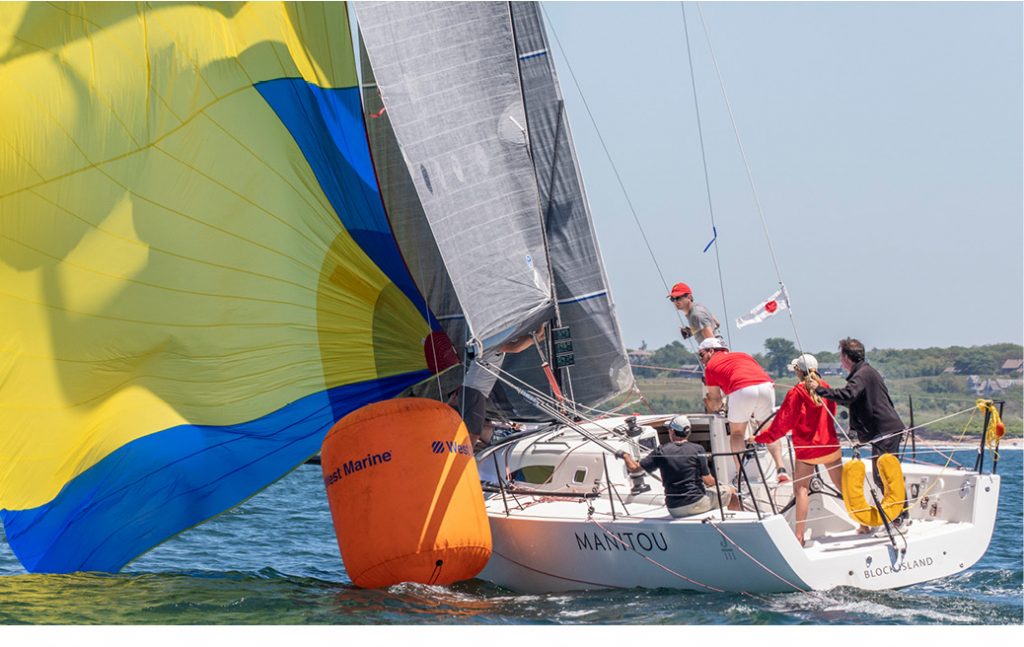When you get to the leeward mark, it’s important to make a good approach and a smooth turn around the mark. But the real measure of a successful rounding is how you come away from the mark. As you begin the next leg, you want good speed, clear air and the ability to follow your upwind strategy.
I call this final part of the rounding an ‘escape’ because often it is just that. With so many other boats nearby, it’s hard to stay in control of your race as you leave the mark behind.
Work hard on speed
The best way to go fast after the mark is by carrying good speed into and through your mark rounding. Get your spinnaker put away early, use your weight and sails to turn the boat, and cut close to the mark.
Make sure to adjust your sail controls for their upwind settings before you get to the mark. Note that the wind is probably different than it was on the first beat. Also, you are likely to find disturbed air and bumpy water around the lee- ward mark. So in order to go fast, set up your sailplan with enough power for those conditions.
When you get around the mark, focus primarily on speed. Get your weight in the optimal position right away, and postpone the clean-up until you are going fast with no other boats to worry about.
The ability to point high is certainly important after the leeward mark, but remember you must be sailing fast before you can go for better height. Also, don’t forget to shift gears. The wind and water may change often right after the leeward mark, so anticipate this and adjust the trim of your sails and boat as necessary to maintain optimal speed.

After rounding the leeward mark, you must be aware of the boats that are still sailing downwind as they will cause disturbed air and bumpy water and may have the right of way. Be sure you look ahead and try to plan the least painful way to sail through the fleet that is still on the run. © Stephen R Cloutier
Fight for clear air
In order to go fast after the leeward mark, your most important priority is almost always finding clear air. Unless you’re in first place, though, this can be tough.
When there are other boats in front of you around the mark, you basically have three options for getting clear air:
1) Pinch up to windward of the boat ahead. This is probably the most common choice, but to make it work, you need a close, tactical rounding. As soon as you clear the mark, luff up nearly head to wind for a couple of seconds. While this will cost you some distance and speed relative to the boat ahead, it will also put you in clearer air to windward of their track.
2) Foot off to leeward of the boat ahead. This is probably a better way to get clear air than pinching above the boat ahead, but it usually means you must fall off to leeward quite a bit. Don’t go for this option when you want to go left on this beat or when there is more than one boat right ahead of you (since footing off below them will just put you in more bad air).
3) Tack. If it’s not possible to stay on the same tack and find clear air, tacking may be your only option to get some breathing room. Be careful, though, since this may take you directly into the bad air, waves and traffic just to windward of the leeward mark. ■
This article originally appeared in David Dellenbaugh’s Speed & Smarts, The newsletter of how-to tips for racing sailors. If you want to sail faster and smarter, log onto SpeedandSmarts.com.
A resident of Easton, CT, Dellenbaugh was tactician and starting helmsman for America3’s successful defense of the America’s Cup in 1992. He’s a Lightning World Champion, two-time Congressional Cup winner, seven-time Thistle National Champion, two-time winner of the Canada’s Cup, three-time Prince of Wales U.S. Match Racing Champion, and a winner of the U.S. Team Racing Championships for the Hinman Trophy.



